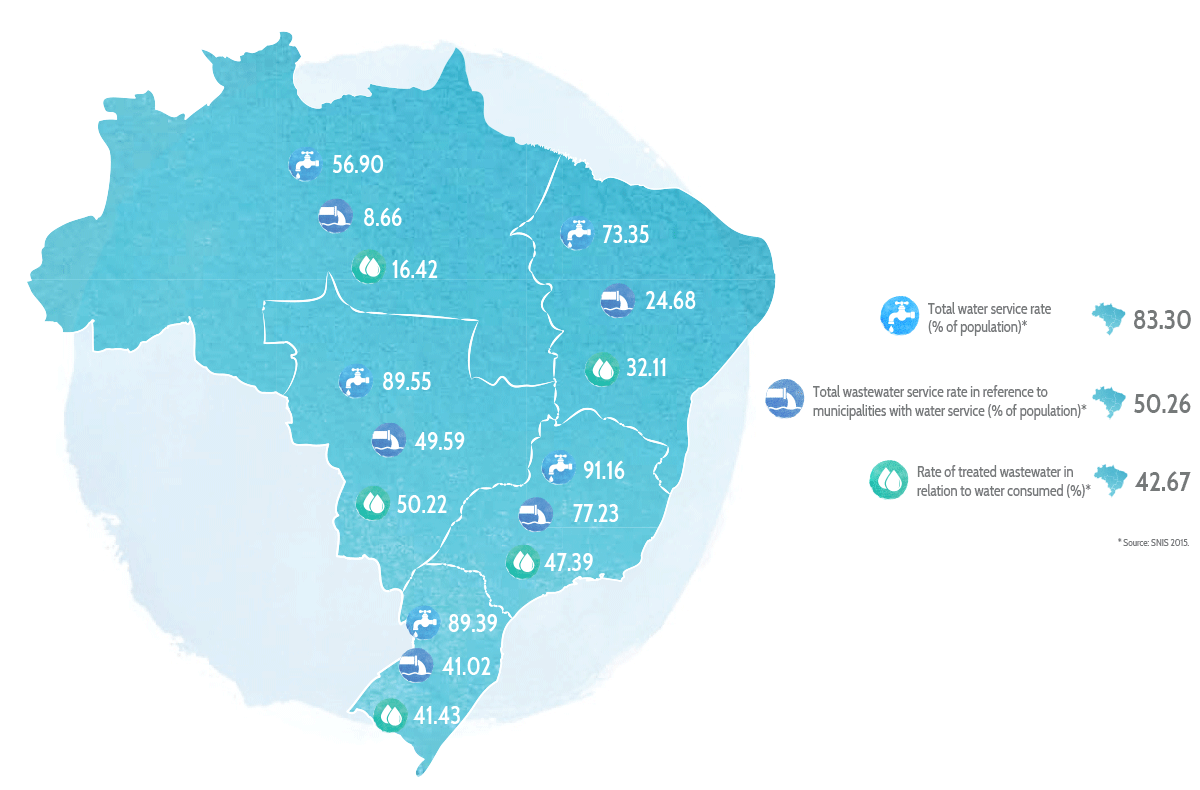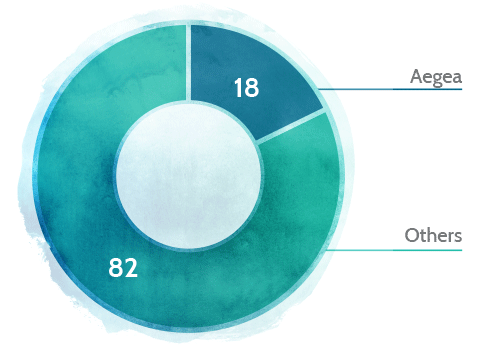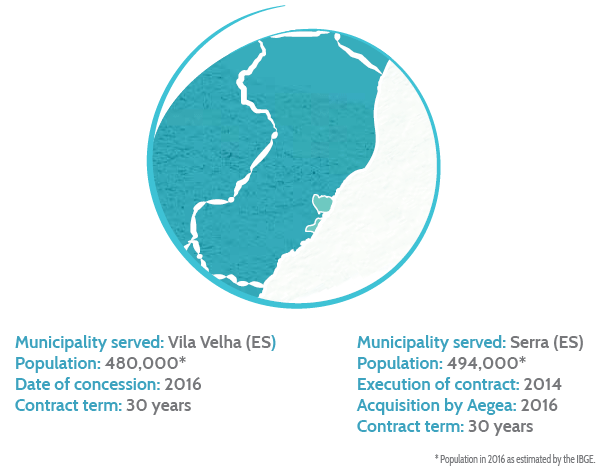Operational performance
G4-DMA Economic performance|G4-DMA Indirect economic impacts|G4-8|G4-EC7During the fiscal year, Aegea executed contracts in Ariquemes (RO), Bombinhas (SC), Serra (ES) and Vila Velha (ES). With this, operations were extended to 47 municipalities and over 4.6 million people were served.
Growth
Municipalities served
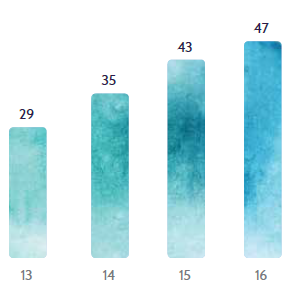
Population served (in millions)
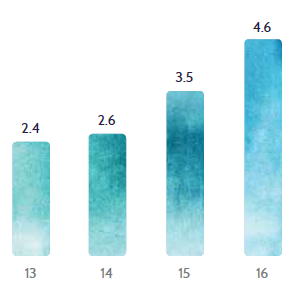
The increase in the user base resulted in billing of the following volumes: 144,800 m3 of water and 78.4 m3 of wastewater, which respectively account for year-over-year growth of 11.6% and 5.7%.
In relation to investments, R$397 million was invested. It is worth mentioning projects in Mato Grosso, where over 200,000 meters of collection systems were installed in the municipalities of Barra do Garças, Campo Verde, Porto Espiridião, Pedra Preta, Sorriso, Sinop and Peixoto de Azevedo.
Projects executed in 2016
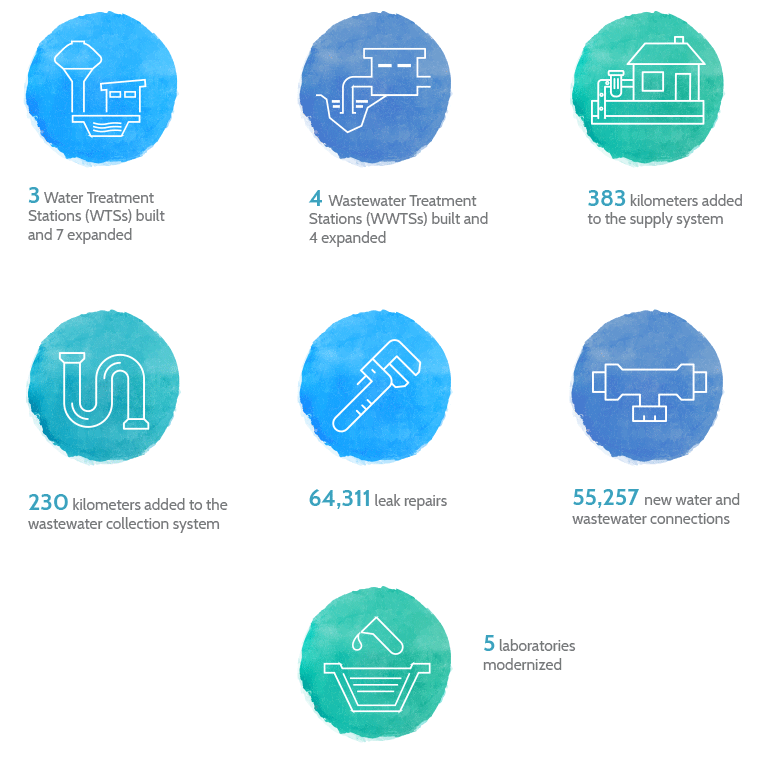
As a result, the average consolidated rate of real and apparent distribution losses3 was 34% – less than the national average (37%). While the consolidated energy efficiency rate was 0.686 kWh/m3. Improvement in these indicators depends on the degree of maturity of each unit.
Notable among the positive impacts of investments are a lower incidence of illnesses related to lack of sanitation and, as a result, less government expenditures on public health; appreciation of property values in areas served; stimulus for tourism; and a stronger local economy. Below are details of the chief investments and operational metrics by concession.
Águas de Meriti4
The wastewater system of São João de Meriti (RJ) has a collection system that is 350 kilometers and two treatment stations. Despite this infrastructure, over 50% is silted, favoring illegal connections and dumping of wastewater into storm drains.
In its first year of operation, Águas de Meriti – in partnership with the Companhia Nacional de Saneamento (CONASA) – worked with a focus on improving, expanding and operating wastewater collection and commercial management of water and wastewater accounts. The concessionaire also promoted replacement of damaged pipelines and carried out repairs of leaks. The goal over the next eight years is to bring access to wastewater services to 90% of the population.
www.aguasdemeriti.com.br.
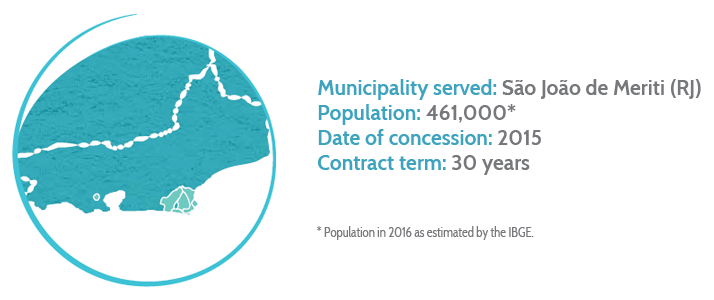
3. Calculated as follows: volume of water produced (m3) + volume of imported treated water (m3) - volume of service water (m3) - volume of water consumed (m3) / volume of water produced (m3) + volume of imported treated water (m3) - volume of service water (m3).
4. Operation and maintenance services for the wastewater systems were temporarily suspended due to contractual obstacles. Nevertheless, data on the unit’s operational performance have yet to be calculated.
Prolagos
The concessionaire completed 18 years of operations in 2016. During this time, R$1.5 billion were put towards building five WWTSs and two WTSs, in addition to technological enhancement (see "Efficiency management").
As a result, the percentage of water coverage went from 30% to 97.12%; moreover, in relation to wastewater treatment, the rate went from zero to 77.14%. These numbers are above the contractual targets stipulated for the period, which are 90% and 70%, respectively. Another result of investments was recovery of the Araruama Lagoon, which had entered environmental failure in 2000, following an algae bloom. The biome is currently once again a tourist spot.
In 2016, an amendment to contract was executed to collect and treat wastewater in Arraial do Cabo (RJ), with an investment of R$25 million for recovery of two WWTs and seven lift stations. Prolagos also invested R$6.9 million in supply – a service that was already provided to the municipality - in order to add over 4.5 kilometers of water pipelines.
In Armação dos Búzios (RJ), operation of the wastewater separation system began through a partnership with the state and municipal governments. With R$5.2 million, raised through the State Environmental Conservation and Urban Development Fund (Fundo Estadual de Conservação Ambiental e Desenvolvimento Urbano – FECAM), the concessionaire built 5.8 kilometers of system around Geribá Lagoon and two lift stations to transport wastewater to the WWTS from the municipality. The separator system is also being installed in São Pedro da Aldeia (RJ) – there will be 18 kilometers for wastewater collection and to send municipal wastewater to WWTSs.
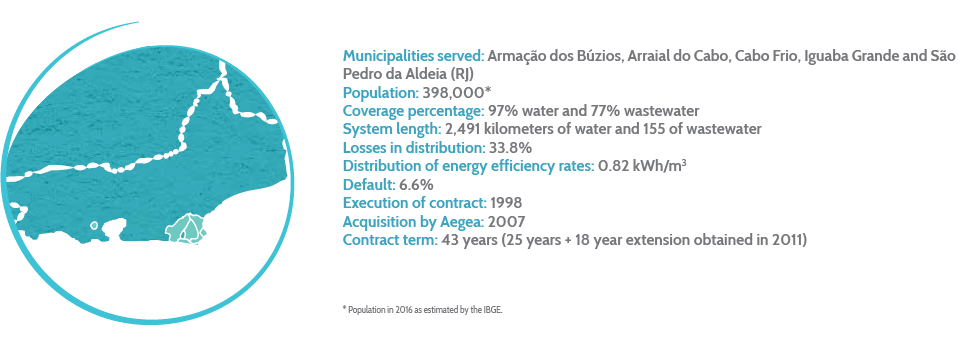
www.prolagos.com.br.
Vila Velha Ambiental5
Concession gained in December 2016 through a bid process with the state government of Espírito Santo through Companhia Espírito Santense de Saneamento (Cesan). The contract establishes investments in improvements to the water distribution system and the effluent treatment and collection system. The target is to universalize wastewater treatment in Vila Velha within 10 years. At the end of 2016, the annual volume of treated wastewater in the municipality was 10 billion liters. The expectation is that 30 billion liters per year of waste will no longer be dumped in the sea and in rivers, streams and trenches by 2037.
Serra Ambiental6
In December 2016, Aegea acquired the Sonel Engenharia S.A. company, which holds a 33.34% stake in Concessionária de Saneamento Serra Ambiental S.A. (CSSA). This unit is responsible for wastewater collection and treatment in the municipality of Serra (ES), according to a contract executed with the state government through Cesan.
During the contract term, a total of over R$400 million is being invested to carry out projects to expand collection systems, wastewater lift stations and WWTSs, as well as for maintenance, expansion and operation of the entire wastewater system. The target is to universalize access to the service by 2025.
5. No measurement of operating data. Contract executed on December 31, 2016.
6. No measurement of operating data. Contract executed on December 31, 2016.
Águas do Mirante
According to the Sanitation Ranking published by Instituto Trata Brasil, Piracicaba (SP) led outstanding municipalities in wastewater treatment: from 2010 to 2015, the year it achieved universal service, it advanced over 60%. Even after meeting this target, the concessionaire continues to make efforts to add to and modernize the municipality’s system. The aim is to keep pace with population growth over the next 30 years, which is the term of the contract.
In 2016, the unit invested in expansion of the Capim Fino WWTS. The project consists of construction of two integrated vertical modules with gas collection and clarification systems, in addition to a contact chamber through which treated effluent will pass. This technology is capable of generating less waste, contributing to reduced environmental impact.
In line with the preservation of natural resources, Águas do Mirante has developed equipment to suction the accumulated sludge in decant tanks. This instrument is the result of effluent studies, especially of industrial waste discarded illegally in the Piracicamirim WWTS. In addition to operational benefits, this measure has resulted in savings of nearly 50% in the amount spent every month on cleaning decant tanks, which went from R$16,500.00 to R$9,300.00.
The unit also developed a pilot project to collect rainwater. The system uses channels and a reservoir capable of storing up to 10,000 liters, which is later used to clean the maintenance yard.
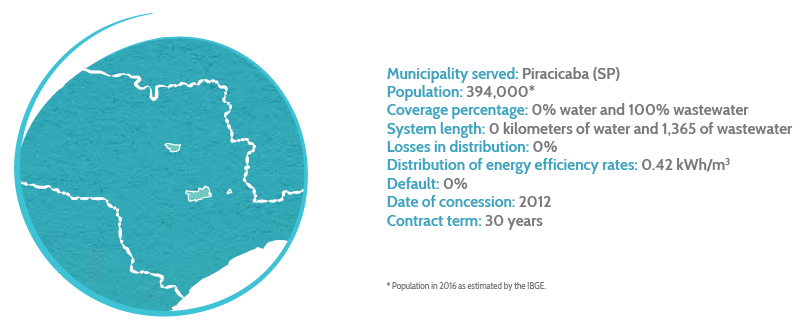
www.aguasdomirante.com.br.
Águas de Matão
Since the start of the Matão (SP) operation in 2013, R$30 million has been invested. During the year, work was concluded on the Jardim Brasil water main and on interconnecting the municipality’s reservoirs, which resolved around 85% of the irregularities in supply, benefitting over 7,000 residents.
In an effort to enhance services, the unit standardized water and wastewater connections and encouraged installation of wastewater inspection chambers and water meter protection boxes. Operational and commercial services were also unified in order to streamline execution of Service Orders.
Águas de Holambra
The concession contract between Aegea and the Water and Wastewater and Urban Drainage Service of Holambra (Serviço de Água e Esgoto e Drenagem Urbana de Holambra – SAEHOL) was executed in late 2015, when Águas de Holambra became responsible for collection, treatment and distribution of water, as well as collection, treatment and final disposal of wastewater.
The concessionaire expects to make investments in replacing water connections, water meters and wastewater systems, in addition to building a wastewater lift station. In 2016, work began to clean reservoirs, monitoring of pressure was enhanced and registers were installed on water main systems - measures aimed at immediately improving the quality of water distributed.
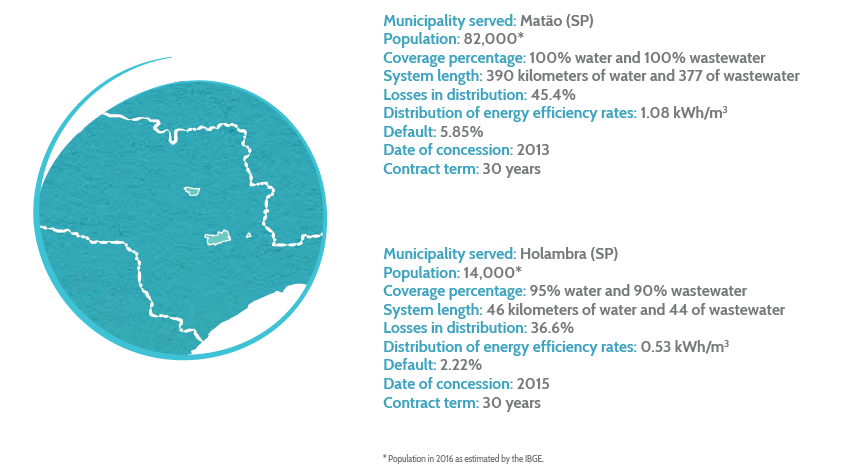
www.aguasdematao.com.br and www.aguasdeholambra.com.br.
Águas Guariroba
During the year, work to expand the wastewater system was intensified, reaching over 11 districts in Campo Grande (MS). The goal is to universalize collection and treatment services in the city by 2025. To do this, R$636 million are being invested in the Sanear Morena 3 Program (see below).
During the year, the “Less Loss, More Water” brochure from the Brazil Global Compact Network, highlighted Águas Guariroba’s reduced losses – from 56% to 19% in ten years - and its investments in universalizing sanitation in Campo Grande (MS) by 2025.
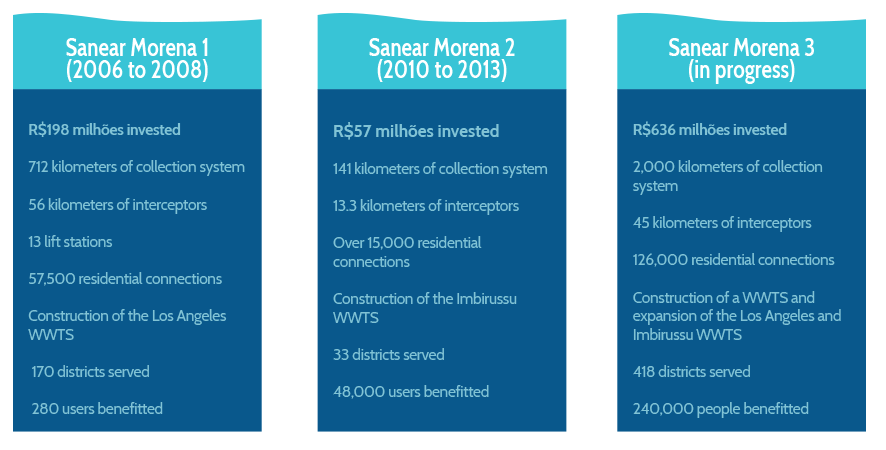
In the last 10 years, the wastewater system in the capital of Mato Grosso do Sul was expanded from 27% to 80%. This growth is inversely proportional to the rate of hospitalizations due to diarrheal diseases, which fell by 91%, according to a study7 published in 2016 which resulted from cross-referencing population data from the Brazilian Institute of Geography and Statistics (Instituto Brasileiro de Geografia e Estatística – IBGE) with information registered with the DATASUS or the Information Technology Department of Brazil’s Unified Health System (Sistema Único de Saúde). In 2003, the municipality had a high of 157 hospitalizations for every 100,000 inhabitants. In 2015, this proportion was 13.7 for every 100,000. G4-EC7
7. Source: “Análise dos Indicadores de Saúde Pública Associadas ao Saneamento Inadequado no Município de Campo Grande (MS) no Período 2003-2015” (Analysis of Public Health Indicators Associated with Inappropriate Sanitation in the Municipality of Campo Grande (MS) in the Period of 2003-2015) study, available at www.aguasguariroba.com.br/relatorio-reducao-doencas.
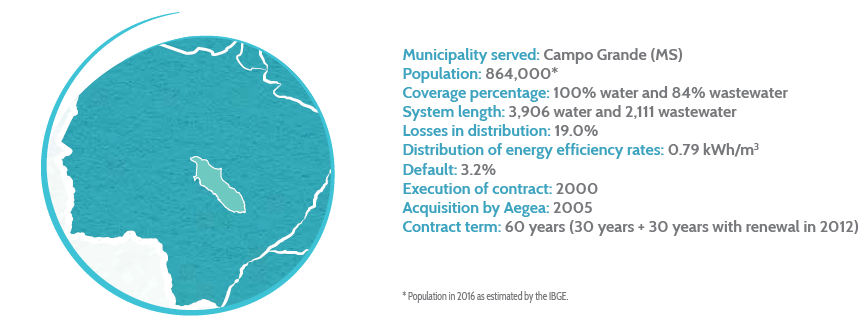
www.aguasguariroba.com.br.
Expansion of the wastewater system to over 80%
Number of properties served (per thousand)

Reduction in hospitalizations due to diarrheal diseases by 91%
Number of hospitalizations/100,000 inhabitants

1. Start of Sanear Morena 1. 2. Start of Sanear Morena 2. 3. Start of Sanear Morena 3.
Águas de Timon
In just one year of operation, the concessionaire reached a 100% supply rate in the urban area of Timon (MA). Over R$20 million were invested through the Timon Saneada 1 Program in works and services, including construction of the Parnaíba WTS – with a capacity of 50 liters per second – and inauguration of the administrative headquarters and of the first service post in the municipality. Moreover, 23 water treatment systems were modernized, installing water meters for 35% of connections and replacing 40 valves and pumps – allowing for the addition of another 40,000 meters to the system.
During the period established in the contract, the unit will invest over R$180 million. During the next year, sanitary wastewater works will begin to expand coverage for wastewater collection and treatment, the goal of which is to go from zero to 100% in 11 years.
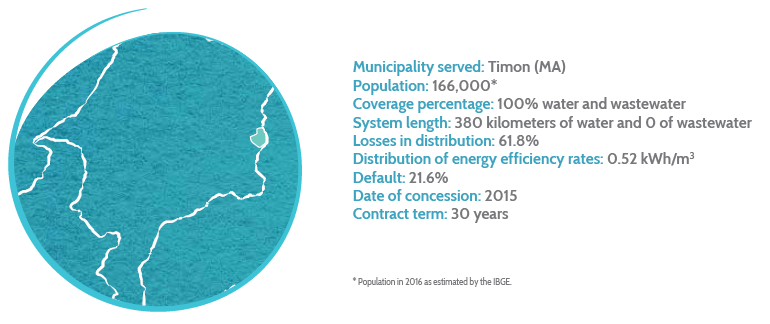
www.aguasdetimon.com.br.
Águas de São Francisco
Since operations began, ten water distribution subsystems have been refurbished and the Vila dos Cabanos WTS was modernized, replacing pumps, aerators and filter material. Over 20 electric panels were also automated for control and monitoring of water distribution systems.
The concessionaire has already reduced electricity consumption by 12.8% through energy efficiency initiatives. This achievement is the result of macromeasurement actions, combating of illegal connections and installation of reservoir water level sensors (see “Efficiency management”).
In 2016, the Barbacena Saneada 1 Program was started, with investments in expansion and modernization of the water supply system. The scope of the initiative includes plans for: implementation of an additional 90 kilometers to the system; installation of 6,700 connections; reactivation and modernization of the Barcarena Sede reservoir; and construction of a reservoir, with a capacity of 3 million liters, and of a treated water lift station.
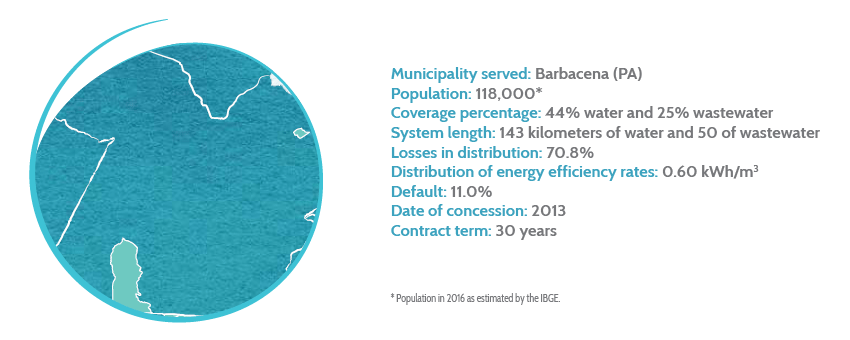
www.aguasdesaofrancisco.com.br.
Nascentes do Xingu
Nascentes do Xingu is responsible for managing 24 operations in Mato Grosso, one in Pará and four in Rondônia. In 2016, it executed a contract to operate in Ariquemes (RO) and maintained investments in improvements to water supply and wastewater collection and treatment, in line with the previous year.
In an effort to keep pace with the growth of Barra do Garças (MT), a new WTS was delivered, increasing treatment capacity by 35% and benefitting every district in the municipality. While in Diamantino (MT), the concessionaire added 21,000 meters to the system and increased storage capacity by 90%.
In Confresa (MT), water treatment operations were doubled with the construction of a WTS with a capacity of 50 liters per hour. Laboratories and water meters were also modernized, in addition to building 52,000 meters of supply system and a reservoir with capacity to store one million liters – guaranteeing quality and regular treated water for more than 1,400 new connections.
Supply capacity was also increased by 80% in the municipality of Novo Progresso (PA), with the construction of another WTS, with a capacity to treat 180 liters per hour. Moreover, over 10,000 meters were added to the network to serve the city’s highest districts.
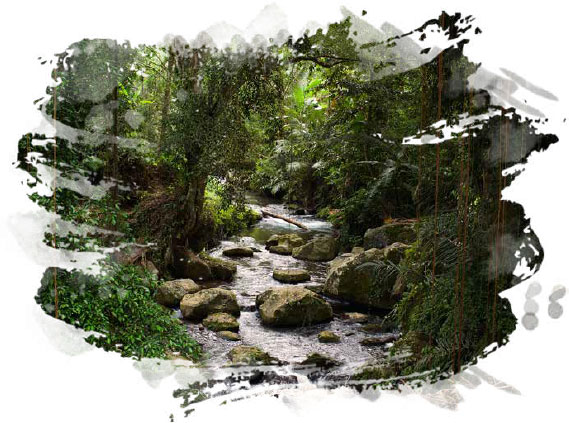
In Buritis (RO), where the unit began operations in April 2015, over 30,000 meters of water system and water mains, a collection system on the Candeias River and a WTS have already been built, in addition to modernizing analysis labs. The goal is to supply quality and regular water to 100% of the urban area within the next five years.
Another operation that began in 2015, Pimenta Bueno (RO), has received funds to modernize the supply system. Among actions are recovery and adaptation of the system, elimination of leaks, new connections and refurbishment of labs.
In relation to wastewater collection and treatment, over 380,000 meters of collection system was added to the cities of Barra do Garças, Campo Verde, Porto Espiridião, Pedra Preta, Sorriso, Sinop, Peixoto de Azevedo, Primavera do Leste and Cláudia (MT) over the last two years – more than half (200,000) was added in 2016. As a result, Barra do Garças, Primavera do Leste and Cláudia were highlighted in a ranking by the State Secretariat of Cities (Secid – Mato Grosso). The respective rates of coverage for these municipalities are 70%, 72% and 84%.
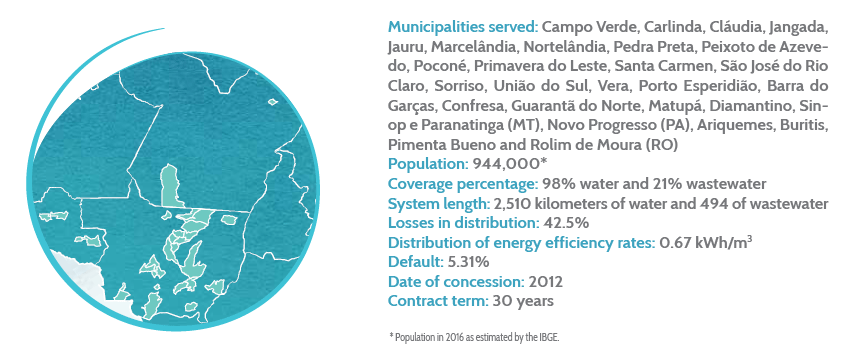
www.nascentesdoxingu.com.br.
Águas de Bombinhas
Concessionaire responsible for water supply and wastewater services in Bombinhas (SC). The contract with the municipal government was executed in August 2016 and stipulates a total investment of approximately R$135 million. The unit’s goal is to install a system and collect and treat 97% of wastewater by 2021, with gradual advances over the subsequent years. At the end of 2016, only 18% of wastewater was appropriately discarded.
Águas de Penha
This unit is responsible for water and wastewater services in Penha (SC). The concession contract was executed in November 2015, with an estimated total investment of R$181 million.
The municipality does not have a WTS and wastewater collection and treatment system, which means it depends on the neighboring city of Balneário Piçarras (SC) for its supply. The short-term goal is to therefore give the region a self-sufficient water supply. A commitment was also made to start building the wastewater system in 2019 and to have a capacity by 2024 to treat 56% of effluents, gradually advancing over the subsequent years until reaching 100% in 2035.
During the year, Águas de Penha earmarked investments for opening a new headquarters, with more integrated facilities, and for adopting a call center at the same standard as other units in the South region. The new structure allowed for improvement in the quality of services and a higher service percentage.
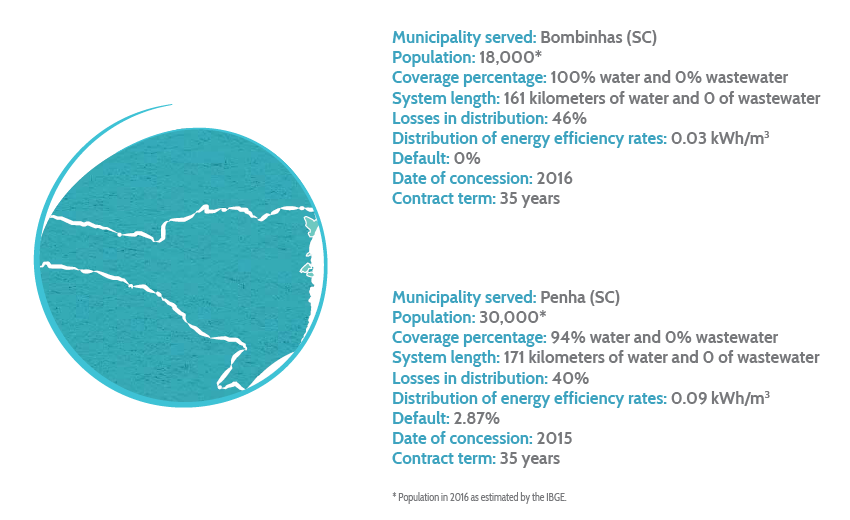
www.aguasbombinhas.com.br and www.aguasdepenha.com.br.
Águas de Camboriú
With a concession contract executed in December 2015, the concessionaire began operations with the goal of providing Camboriú (SC) with its own water treatment system within three years. Wastewater treatment should begin starting in the fourth year of the contract, over the 35-year course of which R$160 million will be invested.
During the year, the concessionaire began the process of reviewing water meters. This initiative helps to identify the need for replacements and allows for adjustments to be made to water consumption readings, which makes billing fairer for users and the unit. The aim is to replace 87% of the city’s water meters in three years – around one-third were already changed out in 2016.
Águas de São Francisco do Sul
In operation for just two years, the concessionaire has already shown positive results for the residents of São Francisco do Sul (SC). One of them is the construction of the Vila da Glória WTS, which began operating in 2016 and has a treatment capacity of 15 liters per second. A 500 m3 reservoir was also delivered to absorb spikes in consumption during the summer season. While at Praia do Ervino, work was finalized to supply one of the region’s main beachside areas. Around R$16 million were invested in building a 16-kilometer-long water main and 100 kilometers of system. Over 9,000 people will benefit from these initiatives.
Another milestone in 2016 was the launch of the Sanear São Chico Program, which started procedures to create the municipality’s first wastewater system. By 2017, R$31 million will be invested; and, over the duration of the contract, over R$220 million will be invested, R$126 million of which will go to wastewater collection and treatment. The goal is for the municipality to have 52% of wastewater treated by 2022, with the expectation of gradually reaching 85%.
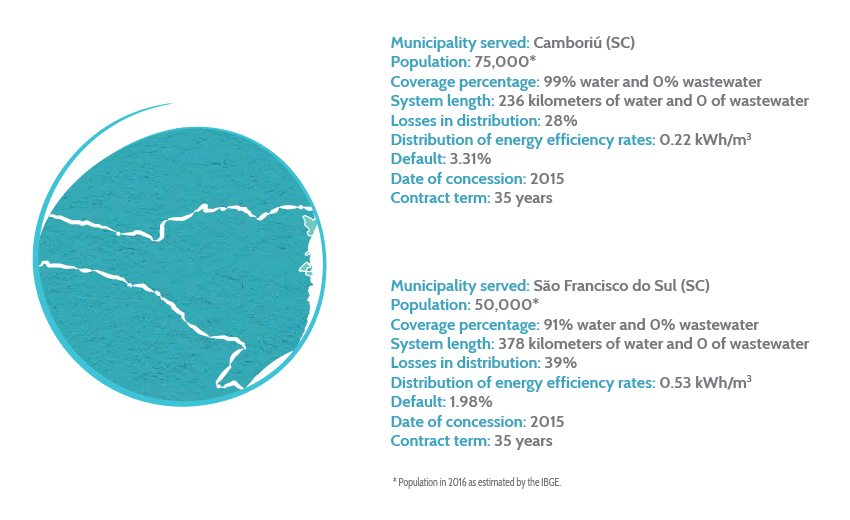
www.aguasdecamboriu.com.br and www.aguasdesaofranciscodosul.com.br.






